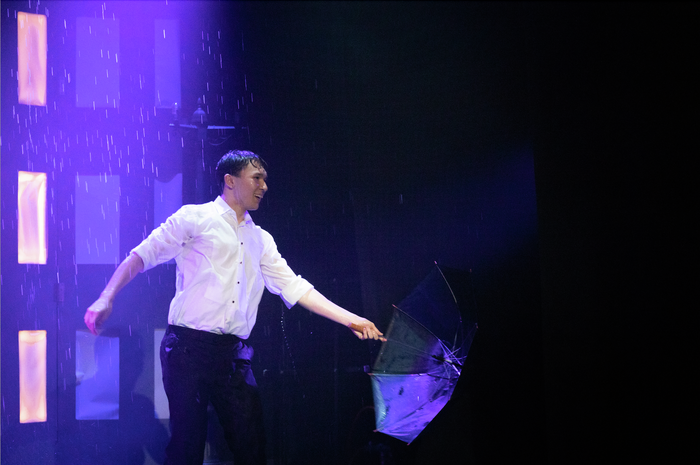All’s well that ends wet
Theatre Editor Bethan Holloway-Strong presents a brief history of the aquatic dramatic

I am slightly obsessed with water. As anyone who’s talked to me for longer than five minutes knows, I grew up on the west coast of Australia and spent most of my childhood in the sea, in the pool, or delighting in drought-quenching rains. I’m not tempted to swim in the Cam – the signs about sewage have slightly put me off – so I’ve indulged my obsession with my English degree. My final dissertation explores swimming pools in contemporary American coming-of-age literature, and it was in the depths of re-drafting this dissertation that I attended Singin’ in the Rain at the ADC last term. I was spellbound by the real water that poured from the rafters and, judging by the delighted gasps around me, the rest of the audience was too.
“Water seems quite dangerous. So why do productions keep using it?”
What is it about water onstage that is so captivating? Humans have been mixing theatre and water since Roman times, when staged naval battles, called naumachia, entertained thousands. The performers, usually prisoners of war or condemned criminals, actually died in these demonstrations, making them a rather bloody affair. Since they were mostly conducted in purpose-dug outdoor basins, though, I’m sure they weren’t hard to clean up. Luckily, by the 19th Century, aquatic theatre had lost the death factor. The Sadler’s Wells Theatre on the outskirts of London staged the first “aqua drama”, which eventually became popular in France and the United States too.

The theatre installed a water tank over the entire stage to perform recreated naval battles. Audiences loved it, with enthusiastic viewers even jumping into the tank to see if the water was real. These interruptions mean the water in the tank, although drained and refilled every three weeks, became filthy. Since each refilling took twelve men twelve hours to complete, the practice wasn’t sustainable, and when audiences began to thin thanks to the weariness of the Napoleonic Wars, the tanks were removed.
Although pumping techniques have evolved since the Archimedes wheel used in Sadler’s Wells, water still presents a considerable technical challenge for modern set designers. In 2016, Beowulf Boritt was nominated for a Tony for his set design for Roundabout Theatre Company’s Thérèse Raquin, which included a river that was deep enough to row a boat in. A leak could be disastrous, prompting him to meticulously install a triple-layered base to the pool. Although this prevented a leak, the pool did spill over once, temporarily flooding the trap room. The water also created a slip hazard for the actors. All in all, it seems quite dangerous. So why do productions keep using it?
As I’ve discovered in my dissertation research, water holds universal spiritual significance. Associated with purification, birth, and life itself, water is a sacred substance that must be treated with respect. It makes sense that we’d want to see it onstage in representations of life; indeed, actress Vanessa Redgrave said that “theatre is as essential to civilisation as safe, pure water”. What happens when water undermines theatre, though? Boritt confessed that he thought long and hard about how to ensure the audience never saw the bottom of the river, lest it “lose all the magic”, and according to writer Natasha Tripney, water on stage can “feel gimmicky”. Its spiritual and emotional significance doesn’t make water immune to looking ridiculous.
“Water confronts the audience with states of being other than their own”
There is something undeniably magical, though, about seeing real water on stage, however “gimmicky” it may be. Everything that happens on stage is, by definition, not real, so to see something so tangible is a pleasant, and confronting, surprise. It’s no wonder those audience members jumped into the tanks at Sadler’s Wells. I, too, found myself examining the umbrellas of the cast of Singin’ in the Rain, almost not believing that the drops were really wet. Seeing real water on stage brings a moving immediacy to the audience members, making the emotional impact of any waterlogged scenes that much more powerful.
Theatre, like water, is transcendent. It aims to bring new experiences and emotions to viewers: to make the audience question their relationships with each other, the world, and art, to push the boundaries of the possible. And what better way to push boundaries than to bring the danger and bliss of water to the stage? It confronts the audience with states of being other than their own, both literal and figurative; as Saoirse Ronan’s Lady Macbeth lay dying in a still pool in Yäel Farber’s 2021 production, she seemed to almost be dissolving. In a time where water levels mark a march towards climate disaster that sometimes seems inevitable, water has more of a place in art than ever before – although I’m very glad I’m not the technical director that has to orchestrate it.
 News / Eight Cambridge researchers awarded €17m in ERC research grants27 December 2025
News / Eight Cambridge researchers awarded €17m in ERC research grants27 December 2025 News / News in Brief: carols, card games, and canine calamities28 December 2025
News / News in Brief: carols, card games, and canine calamities28 December 2025 News / Caius mourns its tree-mendous loss23 December 2025
News / Caius mourns its tree-mendous loss23 December 2025 News / Clare Hall spent over £500k opposing busway 24 December 2025
News / Clare Hall spent over £500k opposing busway 24 December 2025 Interviews / Meet Juan Michel, Cambridge’s multilingual musician29 December 2025
Interviews / Meet Juan Michel, Cambridge’s multilingual musician29 December 2025









